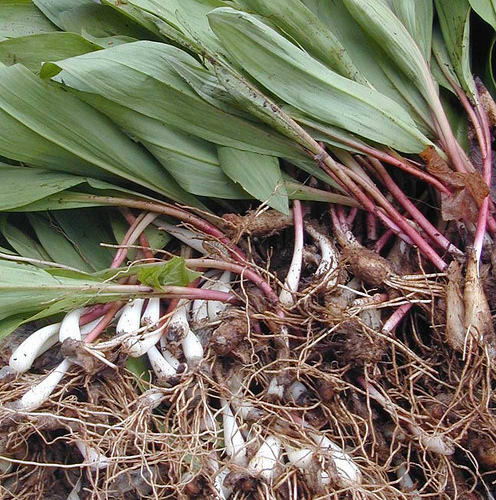The Slippery Slope of Ramps

During April and May ramps are often served in restaurants in the eastern U.S.
This post is part of the Science Tuesday feature series on the USDA blog. Check back each week as we showcase stories and news from USDA’s rich science and research portfolio.
To many of locals in western North Carolina, they’re called wild leeks. Some call them ransoms and still others call them wood garlic because of their pungent smell. Nevertheless, ecologists simply call them ramps. This native plant has been useful to humans since inhabiting the eastern regions of the U.S. and Canada. Still today, locals harvest ramps for food, medicinal preparations, and to sell at markets and spring festivals.
U.S. Forest Service scientist Joan Walker has been monitoring populations of ramps in the mountain coves of western North Carolina for 11 years. The results of her research show that although abundance can vary from year to year, about a quarter of the plots had decreasing ramps cover.
“All of the plots that showed a decrease were where harvesting disturbance was high,” said Walker who is based out of the agency’s Southern Research Station. “Also, harvested plots as a group have reduced ramps populations compared to undisturbed ones.”
These results suggest that it may be time to re-examine the current harvest policy and perhaps take corrective measures to ensure the species will be available for future generations of Americans.
In the Southern Appalachians, many prime sites for harvesting ramps are within national forest boundaries. The National Forest System is responsible for maintaining biological diversity to sustain valuable ecosystem services such as clean air and water, healthy soil, abundant wood, recreational opportunities and other forest-based commodities that include herbs and edible plants.
Ramps are among the first ephemeral greens to emerge during the spring months of March and April. With their electric green leaves, plump, white bulb and distinct odor, ramps are easy to distinguish from other early growers. After a hard winter in the mountains with food stores running low, this green “manna” would have literally been a life saver to both Native Americans and settlers living throughout the region in years past.
Concerns about harvesting effects in the southern range (northern Georgia and Alabama and western North Carolina) prompted Walker’s monitoring study in two areas of the Nantahala National Forest in western North Carolina. The goal of the project is to track the populations over time and to determine if trends are related to local harvesting, weather, or even changing climate. The monitoring study consists of 25 plots distributed between 3,500 feet to just over 5,000 feet in elevation.

Are there domestic varieties now? I have stopped harvesting them since I moved to GA because there simply were not enough. I would gladly grow my own.
(“All of the plots that showed a decrease were where harvesting disturbance was high,” said Walker…“Also, harvested plots as a group have reduced ramps populations compared to undisturbed ones.”)Well Duh, what did you think was gonna happen, they were being harvested!! BUT, I would suspect that if, ‘both Native Americans and settlers living throughout the region in years past”, have been digging Ramps for 5000+ years, we can probably file this CRISIS in the trash can with Global Warming theories.